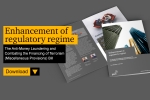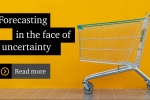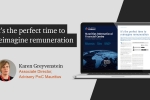The Global Sustainable Development Goals
PwC's commitment to Net Zero
Climate change is one of the most pressing problems facing our world today. It affects everyone - from families worrying about their children’s futures, to pension funds deciding where to invest. So, it is in the interests of everyone that we see systemic change that averts climate catastrophe and unlocks the potential of green growth.
At PwC, we believe the business community has a key role to play in making that happen. And we’re determined to play our part. That’s why we’re making a worldwide science-based commitment to reach net zero greenhouse gas emissions by 2030.
PwC's Net Zero Commitment
Announcement by Bob Moritz: Global Chairman of the PwC network
The Sustainable Development Goals (SDGs) – an overview of the 17 goals.
With 193 governments agreeing to deliver 17 goals tackling major world issues by 2030, change lies ahead for business, not only to rethink strategy and business behaviour to align with the goals, but also to assess and evidence their impact.
Source: Sustainable Development Goals – how will they impact your business? (PwC)
Which of the Global Sustainable Development Goals is relevant to your organisation?

Goal 1: No poverty
No poverty: End poverty in all its forms everywhere.
896 million people live on less than $1.90 a day. Don’t be fooled into thinking it’s just an issue for developing countries - 17% of US citizens are living in poverty too.
What can business do? Pay the minimum wage (even better, pay a living wage), making sure your supply chain does too. Adopting an inclusive business model will make a difference here as well.

Goal 2: Zero hunger
Zero hunger: End hunger, achieve food security and improved nutrition and promote sustainable agriculture
Currently, 870 million people suffer from chronic malnutrition. By 2050, there’ll be 9 billion mouths to feed, that’s 2.3 billion more than in 2009 and requires a 70% increase in food production from 2007 levels and an unprecedented demand for agriculture land. It’ll be exacerbated by climate change which will impact growing conditions, food supply and food security. It’s not just a humanitarian issue though, the decisions that business makes, particularly in food, drink, transport, processing and retail, influence outcomes linking to poverty and food waste too.
What can business do? Support smallholders to improve productivity, reduce exposure to climate and resource scarcity risks, collaborate to improve supply chain resilience, develop new crop varieties, create digital platforms to share specific best practices advice with farmers and promote sustainable farming practices.

Goal 3: Good health and well-being
Good health and well-being: Ensure healthy lives and promote well-being for all at all ages
Non-communicable diseases are on the up – heart disease, cancer, diabetes and respiratory disease are increasing worldwide costing trillions in treatment each year and pushing millions below the poverty line. Depression affects around 300 million people. Nearly 3500 people die from road accidents every day. And infectious diseases (malaria, TB, HIV) still remain a challenge.
Business needs a healthy workforce and thriving consumers so making it easier to adopt and sustain healthy behaviours and implementing mental resilience programmes are sensible approaches.
What can business do? Encourage healthy life-styles in your business and your supply chain – company disease prevention and treatment programmes can make a difference to productivity.

Goal 4: Quality education
Quality education: Ensure inclusive and equitable quality education and promote lifelong learning opportunities for all
59 million children aren’t in primary school and should be. 796 million people are illiterate. Last year, illiteracy cost the global economy over $1trillion. Education is a major driver behind economic growth - increased educational attainment accounts for 50% of the economic growth in OECD countries.
It’s an issue business can’t afford to ignore as it’s driving a skills gap – there are nearly 40 million too few college-educated workers in the global labour market, and a 45 million shortfall in secondary or vocational workers in developing countries.
What can business do? Review your pipeline (what skills will you need, where will you find them) - invest in education to make sure you have the right skills in place. Anticipate how changes in technology will impact your workplace’s training needs.

Goal 5: Gender equality
Gender equality: Achieve gender equality and empower all women and girls
Empowering women is a precondition to solving poverty, inequality and violence against women. In developing countries, closing the pay and access to work gap to equal that of men could mean women could be better off to the tune of $9 trillion. Closing the employment gap between men and women could add $12 trillion to global GDP by 2025 (by advancing women’s equality). $28 trillion would be added if women were to play an identical role to men in the labour markets.
From a business perspective, providing the same pay, promotion, and benefits for work, as well as opportunities to join the board, with disregard to the jobholder’s sex, is a simple strategy that would make a big difference. In addition, firms with greater board level diversity perform better ... looking at the Fortune 500, firms with the highest percentage of women outperform those with the lowest (the top quartile out-performing the bottom quartile by 53% for return on equity and 66% for return on invested capital).
What can business do? Pay men and women the same rate for the work they do. Promote on merit. Implement policies that encourage women to remain in the workplace e.g. flexible working and maternity policies.

Goal 6: Clean water and sanitation
Clean water and sanitation: Ensure availability and sustainable management of water and sanitation for all
One in three people live in a country with moderate to high water stress, and by 2030 nearly half the global population could be facing water scarcity, with demand outstripping supply by 40%. Lost working days as a result of poor sanitation cost the global economy $4 billion annually. Water availability and quality is threatened by pollution, the impacts of climate change, population growth and increasing consumption.
Water is on the risk agenda for many businesses. 20% of water consumption is used by industry and 70% by agriculture - only 10% of water consumption is used for domestic purposes.
What can business do? Measure your water-footprint and take water stewardship seriously eg. reduce, recycle and safely reuse water, repair leakages and implement efficiency improvement initiatives, and promote hygienic behaviours such as regular handwashing with employees and local communities. Check the impact of your water use on the local community, directly and in your supply chain.

Goal 7: Affordable and clean energy
Affordable and clean energy: Ensure access to affordable, reliable, sustainable and modern energy for all
1 in 5 people lack access to modern electricity, while 3 billion people still use kerosene, wood, coal, or dung for cooking and heating. Poor access to energy slows the growth of GDP and contributes to health problems.
Demand for energy is expected to rise by 20–35% by 2030 (already global electricity consumption per person has more than doubled since 1970s). But, it’s not as simple as just generating more energy. Production and use of energy makes up two-thirds of all green house gas emissions which are a key driver of climate change. People and business need access to energy, but energy produced from low carbon technologies.
What can business do? Check your energy efficiency. Source your energy from renewable sources. Check what impact your energy need has on the local community.

Goal 8: Decent work and economic growth
Decent work and economic growth Promote sustained, inclusive and sustainable economic growth, full and productive employment and decent work for all
Business has a big impact on people: 65% of the world’s population are of working age; over 200 million are unemployed; 168 million children are working; 2.3 million deaths are attributed to work with work-related injury or illness costing on average 4% of global GDP. Creating jobs is one of the fundamental ways in which business supports economic growth.
What can business do? Put a value on the economic impact generated by the jobs your company creates to evidence your licence to operate. Check you have a policy on human rights and that it is being adhered to throughout your supply chain. Check what programmes you have in place to reduce workplace injury and recruit and retain people with disability – are both improving?

Goal 9: Industry, innovation and insfractructure
Industry, innovation and infrastructure: Build resilient infrastructure, promote inclusive and sustainable industrialisation and foster innovation
Investments in public services such as energy, transport, ICT infrastructure, waste and water are among the largest and longest-term capital investments that society makes. Adequate and resilient infrastructure underpins future economic growth, has long-lasting effects on the environment, and it helps people access the resources they need for a higher quality of life.
It’s an ongoing process - aged infrastructure needs to be maintained, updated or replaced. It is estimated that the global shortfall on necessary basic infrastructure investments needs is $1 trillion. Globally, about 2.6 billion people cannot access a reliable electricity source, with another 2.6 billion without access to basic sanitation. 1.5 billion people have no access to reliable phone services, and over 4 billion don't have access to the internet.
What can business do? Review your transport and building infrastructure to identify efficiencies. Consider investing in local transport improvements that would deliver a direct business benefit to you. Check how disruptive technologies or innovative business models could impact your market. Explore your digital potential (both what you do and how you do it).

Goal 10: Reduced inequalities
Reduced inequalities: Reduce inequality within and among countries
The gap between rich and poor is widening, both globally and within countries. The richest 1% globally currently have more wealth than the other 99% of the world, while 70% of people live in countries that have worse inequality than 30 years ago. In developed and developing countries alike, the poorest half of the population often controls less than 10% of its wealth.
High levels of inequality harm economic growth and make poverty reduction more difficult. Unequal societies suffer from increased levels of unemployment, social instability (including households in financial distress and higher divorce rates) and crime. This all equates to a less stable business environment.
What can business do? Agree and implement an acceptable ratio between your highest paid executive earnings and the earnings of your lowest paid workers. Pay a living wage (including your interns and apprentices) to help social mobility. Have equal opportunity policies for your foreign workers.

Goal 11: Sustainable cities and communities
Sustainable cities and communities: Make cities and human settlements inclusive, safe, resilient and sustainable
Cities are economic powerhouses, generating more than 80% of global GDP. Over half of the world’s population live in urban areas, this will rise to two thirds by 2050. But there are downsides: social problems are concentrated in urban spaces, including extreme poverty, housing shortages and slum settlements; and they are centres of environmental degradation. Urban areas also have a crucial role to play in tackling climate change, as almost 70% of global greenhouse gas emissions come from cities.
Cities are important as centres of business activity, providing companies with concentrated populations of potential customers and employees. Poorly designed cities put barriers in the way of doing business effectively; but a well-planned urban environment, with effective transport and reliable municipal services, reduces the costs of doing business and improves productivity.
What can business do? Carry out a social and environmental impact assessment. Put in place a community engagement strategy. Achieve a green building certification for your premises. Set and meet your transport emission and pollution reduction targets. Introduce home working.

Goal 12: Responsible consumption and production
Responsible consumption and production: Ensure responsible consumption and production patterns
A rising population, urbanisation and, overwhelmingly, economic growth, are driving an ever increasing demand for natural resources: energy, soil, water and minerals. But if current consumption trends continue, natural resources could be rapidly depleted.
Increased consumption is driving an increase in waste e.g. discarded materials from municipal, electrical and electronic, to industrial and agricultural waste which in turn feeds an increase in disposal costs and environmental / health impacts. Waste incineration raises concerns about air pollution, while landfill sites leak methane – a potent greenhouse gas which exacerbates climate change.
In addition, massive quantities of food are wasted - one third of all the food produced in the world for human consumption gets lost or wasted every year. And, e-waste (mobile phones and tablets) is one of the fastest growing waste streams leaving a toxic legacy of heavy metals and chemicals.
What can business do? Check what you are doing to manage scarce resources. Set and meet targets to reduce energy and resource intensity in production and use. Assess the waste disposal of your company. Reduce the need for new resources and waste disposal by extending product life, repairing, reusing, re-manufacturing and recycling products. Adopt circular economy principles.

Goal 13: Climate action
Climate action: Take urgent action to combat climate change and its impacts
Climate change and weather extremes already affect millions of people around the world. Studies predict more frequent and severe events (droughts, heat waves, wildfires, sea level rise and floods) causing damage to coastlines and crops, jeopardising global food and water resources and threatening power supplies. Additional disruptions come from threats to unique systems such as coral reefs, and large-scale singular events like the disintegration of the western Antarctic ice sheet, which would raise sea level by 5 metres. The costs of extreme weather events can be huge.
Climate impact already affects one third of businesses. Many are planning for an increase in frequency of extreme events and the size of impact too.
What can business do? Reduce your greenhouse gas emissions and reliance on carbon. Review your energy mix and increase your reliance on renewable sources. Assess your risk exposure to potential future change impacts (for you direct business and your supply chain). Develop a disaster recovery plan.

Goal 14: Life below water
Life below water: Conserve and sustainably use the oceans, seas and marine resources for sustainable development
We rely heavily on our oceans: The market value of marine and coastal resources and industries is estimated at $3 trillion per year or about 5 per cent of global GDP. More than 3 billion people depend on the oceans for protein (it’s the world’s largest source).
But we invest little in maintaining them:
- 40% of the oceans are suffering ill effects from human activities, including pollution, depleted fisheries, and loss of coastal habitats. Currently, 80-90% of marine pollution comes from land-based activities: everything from fertiliser and pesticide runoff from farms and lawns, to untreated sewage and improperly disposed of garbage.
- Plastic makes up the majority of marine debris. Plastic is particularly problematic because it is not biodegradable but instead gradually breaks up into smaller pieces that are mistaken for food by birds, fish and other marine life, with potentially fatal consequences.
- Oceans are becoming more acidic. Carbon dioxide dissolves readily in seawater to become a marine pollutant of global proportions that could have significant consequences on marine organisms e.g. disruption of marine food webs and ecosystems, potentially damaging fishing, tourism and other human activities connected to the seas and having serious impacts on food security.
What can business do? Review how much plastic packaging your products need and look for opportunities to reduce, reuse or recycle.

Goal 15: Life on land
Life on land: Protect, restore and promote sustainable use of terrestrial ecosystems, sustainably manage forests, combat desertification, halt and reverse land degradation and halt biodiversity loss
Do we value our planet enough? Plants provide 80% of our diet and land habitats provide a range of crucial functions (terrestrial ecosystems e.g. forests, grasslands and wetlands clean our air and water, regulate our climate, manage pests and diseases, provide pollinators for our crops, control flooding, and fix and circulate nutrients to maintain fertile soils). Biodiversity (the number, variety and variability of living organisms in an ecosystem) has intrinsic, scientific and economic value.
Pollution, climate change, invasive species, overexploitation and land use change are causing unprecedented shifts, and in many cases degradation, of terrestrial ecosystems. Both natural biodiversity and genetic diversity of crops and livestock are in sharp decline, with up to 30% of mammal, bird and amphibian species at risk of extinction due to human drivers.
What can business do? Put a value on your environmental impact and work to reduce it. Consider whether environmental degradation and/or biodiversity loss could affect your continuity of supply e.g. decreasing soil fertility could lead to crop failure. Consider certification of sustainably sourced soy, palm oil and timber/paper, work to eliminate paper waste by reducing, reusing and recycling, and only buying from certified sustainable forest sources.

Goal 15: Peace, justice and strong institutions
Peace and justice; strong institutions: Promote peaceful and inclusive societies for sustainable development, provide access to justice for all and build effective, accountable and inclusive institutions at all levels
Worldwide, more than 1.2 billion people live in areas affected by conflict and fragility. (Fragility covers five dimensions - violence, justice, institutions (including effective governments and regulatory bodies), economic foundations and resilience). Corruption, bribery, theft and tax evasion (all illicit financial flows) cost developing countries around US $1.26 trillion per year. More than 6 billion people live in countries with a serious corruption problem.
Just, peaceful and inclusive societies provide a firm foundation for business to thrive. All companies need to play a part in creating a fair environment for business by complying with laws and regulations, improving transparency, protecting whistle-blowers and setting the highest standards of integrity amongst their workforces.
What can business do? Check how robust your compliance is with local laws governing tax and trade practices in all your countries of operation. And that you’re keeping pace with changes in laws and regulations. Put in place a corporate company code of ethics or conduct and provide training on it.

Goal 17: Partnership for the goals
Partnerships for the goals: Strengthen the means of implementation and revitalise Global Partnership for Sustainable Development
Implementing the SDGs will require huge global investment in infrastructure; climate change mitigation and adaptation; health and education; peace and security etc. Estimates for financing this global investment range between $5 trillion and $7 trillion per year. This is financing on an unprecedented scale and will require a step-change in both public and private investment. Already a funding shortfall in developing countries alone is estimated to be $2.5 trillion per year.
Partnerships provide opportunities for business to achieve more than they can alone. Capacity building helps create stronger economies in developing countries, enhancing the commercial environment.
What can business do? Play a role in shaping a system wide approach to addressing one/some of the SDG targets. Help suppliers build their capacity to participate (e.g. by facilitating trade credit, skills building or technology transfer) in your value chain or deliver a better product or service to you if they are already involved.













